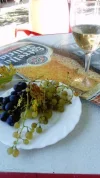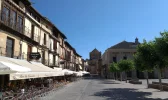Calimocho
Mark
- Time of past OR future Camino
- Oct. 2006 - Roncesvalles to Los Arcos
Oct. 2016 - Los Arcos to Burgos
While walking a section of the Camino from Los Arcos to Burgos, I not only enjoyed walking through vineyards, but sampling the local wines at the end of the day. I was sorry that I didn't know a little more about the varieties, though, so that I would know what to order if I wanted to try a wine that was produced in that region. Now that I'm back home, I have a year to do my "research", but I thought some of you might have some insight concerning the wine - and also beer - of Spain. Are there any interesting wines that you tried along the way? Is there any particular way to order them - similar to the way you ask for a caña when you want a small glass of draft beer? What do they call the beer that seems to be mixed with lemonade? I was also intrigued by the bowl-like glass in which my white wine was served in Logroño. Is this glass used for only a certain variety?


























